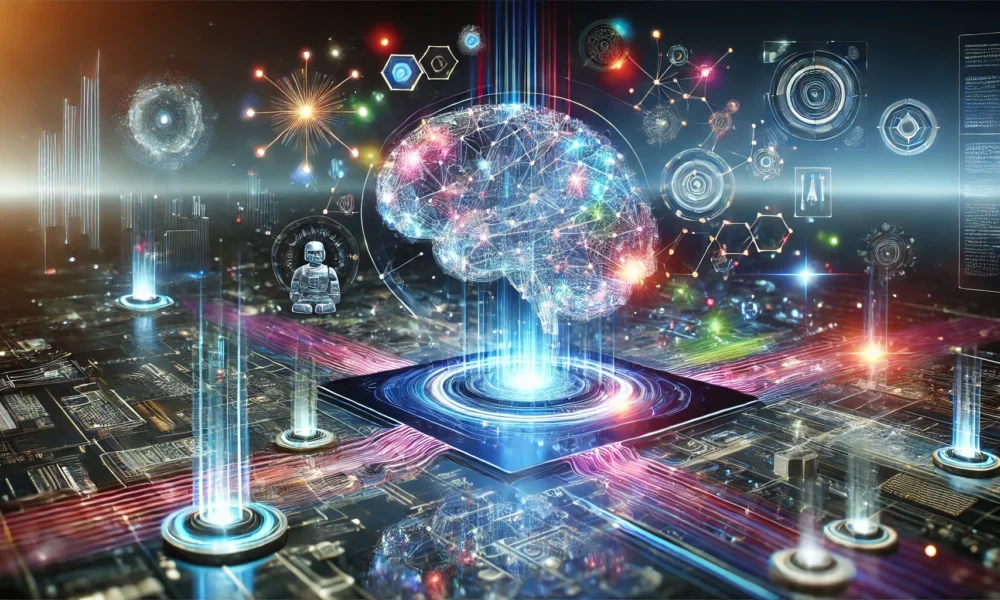Transforming AI with AWS’s Automated Evaluation Framework for Large Language Models
Large Language Models (LLMs) are revolutionizing the field of Artificial Intelligence (AI), powering innovations that range from customer service chatbots to sophisticated content generation tools. However, as these models become increasingly complex, ensuring the accuracy, fairness, and relevance of their outputs presents a growing challenge.
To tackle this issue, AWS’s Automated Evaluation Framework emerges as a robust solution. Through automation and advanced metrics, it delivers scalable, efficient, and precise evaluations of LLM performance. By enhancing the evaluation process, AWS enables organizations to monitor and refine their AI systems effectively, fostering trust in generative AI applications.
The Importance of Evaluating LLMs
LLMs have showcased their potential across various sectors, handling tasks like inquiry responses and human-like text generation. Yet, the sophistication of these models brings challenges, such as hallucinations, biases, and output inconsistencies. Hallucinations occur when a model generates seemingly factual but inaccurate responses. Bias manifests when outputs favor specific groups or ideas, raising significant concerns in sensitive areas like healthcare, finance, and law—where errors can have dire consequences.
Proper evaluation of LLMs is critical for identifying and addressing these issues, ensuring reliable results. Nevertheless, traditional evaluation methods—whether human assessments or basic automated metrics—fall short. Human evaluations, though thorough, can be labor-intensive, costly, and subject to biases. In contrast, automated metrics offer speed but may miss nuanced errors affecting performance.
Thus, a more advanced solution is needed, and AWS’s Automated Evaluation Framework steps in to fill this gap. It automates evaluations, providing real-time assessments of model outputs, addressing issues like hallucinations and bias while adhering to ethical standards.
AWS’s Overview of the Automated Evaluation Framework
Designed to streamline and expedite LLM evaluation, AWS’s Automated Evaluation Framework presents a scalable, flexible, and affordable solution for businesses leveraging generative AI. The framework incorporates a variety of AWS services—including Amazon Bedrock, AWS Lambda, SageMaker, and CloudWatch—to create a modular, end-to-end evaluation pipeline. This setup accommodates both real-time and batch assessments, making it applicable for diverse use cases.
Core Components and Features of the Framework
Evaluation via Amazon Bedrock
At the heart of this framework lies Amazon Bedrock, which provides pre-trained models and evaluation tools. Bedrock allows businesses to evaluate LLM outputs based on crucial metrics like accuracy, relevance, and safety without needing custom testing solutions. The framework supports both automatic and human-in-the-loop assessments, ensuring adaptability for various business applications.
Introducing LLM-as-a-Judge (LLMaaJ) Technology
A standout feature of the AWS framework is LLM-as-a-Judge (LLMaaJ), utilizing advanced LLMs to rate the outputs of other models. By simulating human judgment, this technology can slash evaluation time and costs by up to 98% compared to traditional approaches while ensuring consistent quality. LLMaaJ assesses models on various metrics, including correctness, faithfulness, user experience, instruction adherence, and safety, seamlessly integrating with Amazon Bedrock for both custom and pre-trained models.
Tailored Evaluation Metrics
The framework also enables customizable evaluation metrics, allowing businesses to adapt the evaluation process to align with their unique requirements—be it safety, fairness, or industry-specific precision. This flexibility empowers companies to meet performance goals and comply with regulatory standards.
Modular Architecture and Workflow
AWS’s evaluation framework features a modular and scalable architecture, making it easy for organizations to integrate it into existing AI/ML workflows. This modular design allows for individual adjustments as organizations’ needs evolve, offering flexibility for enterprises of all sizes.
Data Collection and Preparation
The evaluation process kickstarts with data ingestion, during which datasets are collected, cleaned, and prepared for analysis. AWS tools like Amazon S3 provide secure storage, with AWS Glue for data preprocessing. The datasets are formatted for efficient processing during evaluation (e.g., JSONL).
Cloud-Based Compute Resources
The framework leverages AWS’s scalable computing capabilities, including Lambda for short, event-driven tasks, SageMaker for complex computations, and ECS for containerized workloads. These services ensure efficient evaluations, regardless of the task’s scale, using parallel processing to accelerate performance for enterprise-level model assessments.
Evaluation Engine Functionality
The evaluation engine is a pivotal component, automatically testing models against predefined or custom metrics, processing data, and producing detailed reports. Highly configurable, it allows businesses to incorporate new evaluation metrics as needed.
Real-Time Monitoring and Insights
Integration with CloudWatch offers continuous real-time evaluation monitoring. Performance dashboards and automated alerts enable businesses to track model efficacy and respond promptly. Comprehensive reports provide aggregate metrics and insights into individual outputs, facilitating expert analysis and actionable improvements.
Boosting LLM Performance with AWS
AWS’s Automated Evaluation Framework includes features that markedly enhance LLM performance and reliability, assisting businesses in ensuring accurate, consistent, and safe outputs while optimizing resources and curbing costs.
Automated Intelligent Evaluations
A key advantage of AWS’s framework is its process automation. Traditional evaluation methods can be slow and prone to human error. AWS streamlines this, saving time and money. By conducting real-time model evaluations, the framework can swiftly identify output issues, allowing for rapid responses. Evaluating multiple models simultaneously further facilitates performance assessments without overwhelming resources.
Comprehensive Metrics Assessment
The AWS framework employs diverse metrics for robust performance assessment, covering more than just basic accuracy:
Accuracy: Confirms alignment of model outputs with expected results.
Coherence: Evaluates the logical consistency of generated text.
Instruction Compliance: Assesses adherence to provided guidelines.
Safety: Checks outputs for harmful content, ensuring no misinformation or hate speech is propagated.
Additional responsible AI metrics also play a crucial role, detecting hallucinations and identifying potentially harmful outputs, thus maintaining ethical standards, particularly in sensitive applications.
Continuous Monitoring for Optimization
AWS’s framework also supports an ongoing monitoring approach, empowering businesses to keep models current as new data or tasks emerge. Regular evaluations yield real-time performance feedback, creating a feedback loop that enables swift issue resolution and sustained LLM performance enhancement.
Real-World Influence: AWS’s Framework in Action
AWS’s Automated Evaluation Framework is not merely theoretical—it has a proven track record in real-world settings, demonstrating its capacity to scale, bolster model performance, and uphold ethical standards in AI implementations.
Scalable and Efficient Solutions
A standout feature of AWS’s framework is its efficient scalability as LLMs grow in size and complexity. Utilizing serverless technologies like AWS Step Functions, Lambda, and Amazon Bedrock, the framework dynamically automates and scales evaluation workflows. This minimizes manual involvement and optimizes resource usage, facilitating assessments at production scale. Whether evaluating a single model or managing multiple models simultaneously, this adaptable framework meets diverse organizational requirements.
By automating evaluations and employing modular components, AWS’s solution integrates smoothly with existing AI/ML pipelines, helping companies scale initiatives and continually optimize models while adhering to high-performance standards.
Commitment to Quality and Trust
A crucial benefit of AWS’s framework is its focus on sustaining quality and trust within AI systems. By incorporating responsible AI metrics, including accuracy, fairness, and safety, the framework ensures that models meet stringent ethical benchmarks. The blend of automated evaluations with human-in-the-loop validation further enables businesses to monitor LLM reliability, relevance, and safety, fostering confidence among users and stakeholders.
Illustrative Success Stories
Amazon Q Business
One notable application of AWS’s evaluation framework is in Amazon Q Business, a managed Retrieval Augmented Generation (RAG) solution. The framework combines automated metrics with human validation to optimize model performance continuously, thereby enhancing accuracy and relevance and improving operational efficiencies across enterprises.
Improving Bedrock Knowledge Bases
In Bedrock Knowledge Bases, AWS integrated its evaluation framework to refine the performance of knowledge-driven LLM applications. This framework enables effective handling of complex queries, ensuring generated insights remain relevant and accurate, thereby delivering high-quality outputs and asserting LLMs’ roles in effective knowledge management systems.
Conclusion
AWS’s Automated Evaluation Framework is an essential resource for augmenting the performance, reliability, and ethical standards of LLMs. By automating evaluations, businesses can save time and costs while ensuring that models are accurate, safe, and fair. Its scalability and adaptability make it suitable for projects of all sizes, integrating seamlessly into existing AI workflows.
With its comprehensive metrics including responsible AI measures, AWS guarantees that LLMs adhere to high ethical and performance criteria. The framework’s real-world applications, such as Amazon Q Business and Bedrock Knowledge Bases, verify its practical value. Ultimately, AWS’s framework empowers businesses to optimize and expand their AI systems confidently, establishing a new benchmark for generative AI evaluations.
Sure! Here are five FAQs based on the concept of transforming LLM performance through AWS’s Automated Evaluation Framework.
FAQ 1: What is the AWS Automated Evaluation Framework?
Answer: The AWS Automated Evaluation Framework is a structured approach to assess and improve the performance of large language models (LLMs). It utilizes automated metrics and evaluations to provide insights into model behavior, enabling developers to identify strengths and weaknesses while streamlining the model training and deployment processes.
FAQ 2: How does the framework enhance LLM performance?
Answer: The framework enhances LLM performance by automating the evaluation process, which allows for faster feedback loops. It employs various metrics to measure aspects such as accuracy, efficiency, and response relevance. This data-driven approach helps in fine-tuning models, leading to improved overall performance in various applications.
FAQ 3: What types of evaluations are included in the framework?
Answer: The framework includes several types of evaluations, such as benchmark tests, real-world scenario analyses, and user experience metrics. These evaluations assess not only the technical accuracy of the models but also their practical applicability, ensuring that they meet user needs and expectations.
FAQ 4: Can the framework be integrated with existing LLM training pipelines?
Answer: Yes, the AWS Automated Evaluation Framework is designed for easy integration with existing LLM training pipelines. It supports popular machine learning frameworks and can be customized to fit the specific needs of different projects, ensuring a seamless evaluation process without disrupting ongoing workflows.
FAQ 5: What are the benefits of using this evaluation framework for businesses?
Answer: Businesses benefit from the AWS Automated Evaluation Framework through improved model performance, faster development cycles, and enhanced user satisfaction. By identifying performance gaps early and providing actionable insights, companies can optimize their LLM implementations, reduce costs, and deliver more effective AI-driven solutions to their users.
Feel free to let me know if you need any further details!










